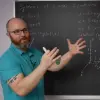

NARROW DISPLAY WARNING
You are most likely using a tablet or mobile device in portrait orientation. This website is best viewed using a typical computer screen with the browser window maximized.
Viewing this website in portrait orientation can cause problems with equations being longer than the screen width (you can scroll to the right), images being poorly sized, and the font size of maths text being much smaller than regular text. If your only option is a tablet or mobile device, your viewing experience will be better if you view this website in landscape orientation. You might need to refresh the page to fix any problems after rotating.
The Wrońskian is useful for determining the linear independence of a set of n homogenous solutions to an nth order linear ODE. The Wrońskian is a determinant of the n homogenous solutions and their first (n-1) derivatives. The Wrońskian is used in the Variation of Parameters formula and in Abel's Identity.
Given $n$ functions $y_{1}(x)$ to $y_{n}(x)$, the Wrońskian is defined as,
\begin{equation} W(y_{1},y_{2},\ldots,y_{n}) = \text{det} \begin{bmatrix} y_{1} & y_{2} & \ldots & y_{n} \\ y_{1}' & y_{2}' & \ldots & y_{n}' \\ \vdots & \vdots & & \vdots \\ y_{1}^{(n-1)} & y_{2}^{(n-1)} & \ldots & y_{n}^{(n-1)} \end{bmatrix} \end{equation}For just two functions, the Wrońskian evaluates to,
\begin{equation} W(y_{1},y_{2}) = \text{det} \begin{bmatrix} y_{1} & y_{2} \\ y_{1}' & y_{2}' \end{bmatrix} = y_{1}y_{2}' - y_{1}'y_{2} \end{equation}When solving an IVP of the form,
\begin{equation} y'' +p(x)y' +q(x)y = 0 \qquad y(x_{0}) = y_{0} \qquad y'(x_{0}) = y'_{0} \end{equation}We'd like to verify that we can solve for any initial condition and that the two homogeneous solutions $y_{1}(x)$ and $y_{2}(x)$ we found are fundamentally different from each other. By writing the equations for the initial conditions as a matrix equation, we can use the tools of linear algebra to figure out.
\begin{equation} y(x) = c_{1}y_{1}(x)+c_{2}y_{2}(x) \end{equation} \begin{equation} y(x_{0}) = c_{1}y_{1}(x_{0})+c_{2}y_{2}(x_{0}) = y_{0} \end{equation} \begin{equation} y'(x_{0}) = c_{1}y_{1}'(x_{0})+c_{2}y_{2}'(x_{0}) = y'_{0} \end{equation} \begin{equation} \begin{bmatrix} y_{1}(x_{0}) & y_{2}(x_{0}) \\ y_{1}'(x_{0}) & y_{2}'(x_{0}) \end{bmatrix}\begin{bmatrix} c_{1} \\ c_{2} \end{bmatrix} = \begin{bmatrix} y_{0} \\ y'_{0} \end{bmatrix} \end{equation}The determinant of the matrix is the Wrońskian $W(y_{1},y_{2})$ evaluated at $x=x_{0}$, and the matrix equation is guaranteed to have a solution if and only if the determinant of the matrix is nonzero. Another name for this is the two homogenous solutions $y_{1}(x)$ and $y_{2}(x)$ are linearly independent functions and form a fundamental set of solutions to the differential equation.
Given $y_{1}(x),y_{2}(x),\ldots,y_{n}(x)$ solve an IVP with ODE
\begin{equation} y^{(n)} + p_{n-1}(x)y^{(n-1)} + p_{n-2}(x)y^{(n-2)} + \cdots + p_{0}(x)y = 0 \end{equation}If $W(y_{1},y_{2},\ldots,y_{n}) \neq 0$ except at isolated points in an interval $I$, then the set of functions $y_{1},y_{2},\ldots,y_{n}$ form a fundamental set of solutions on the interval $I$.
Reading this very carefully, the theorem doesn't say the functions $y_{1}(x),y_{2}(x),\ldots,y_{n}(x)$ will be linearly dependent if the $W(y_{1},y_{2},\ldots,y_{n}) = 0$ in an interval $I$ instead of just isolated points. In fact, the set of functions can be linearly independent if $W(y_{1},y_{2},\ldots,y_{n}) = 0$ in an interval $I$. The only thing the theorem guarantees is $y_{1}(x),y_{2}(x),\ldots,y_{n}(x)$ are linearly independent if $W(y_{1},y_{2},\ldots,y_{n}) \neq 0$ except at isolated points in an interval $I$. If $W(y_{1},y_{2},\ldots,y_{n}) = 0$ in an interval $I$, the set of functions $y_{1}(x),y_{2}(x),\ldots,y_{n}(x)$ may or may not be linearly independent in the interval $I$.
For the IVP, when the $W(y_{1},y_{2},\ldots,y_{n}) \neq 0$ at $x = x_{0}$, then the IVP will have a solution. If the $W(y_{1},y_{2},\ldots,y_{n}) = 0$ at $x = x_{0}$, the IVP may or may not have a solution.
Calculate the Wrońskian and determine what interval the theorem guarantees linear independence.
\begin{equation} y'' - 3y' + 2y = 0 \qquad W(e^{x},e^{2x}) \end{equation}Calculate the Wrońskian and determine what interval the theorem guarantees linear independence.
\begin{equation} y'' + y = 0 \qquad W\big(\cos(x),\sin(x)\big) \end{equation}Calculate the Wrońskian and determine what interval the theorem guarantees linear independence.
\begin{equation} (x^{2}-2x)y''+(-2x+2)y'+2y=0 \qquad W(x^{2},x-1) \end{equation}Calculate the Wrońskian and determine what interval the theorem guarantees linear independence, and compare that to where the functions are actually linearly independent.
\begin{equation} W\big(x^{2},x|x|\big) \end{equation}Calculate the Wrońskian and determine what interval the theorem guarantees linear independence, and compare that to where the functions are actually linearly independent.
\begin{equation} W(x,1,3x-2) \end{equation}